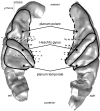Effects of selective attention on the electrophysiological representation of concurrent sounds in the human auditory cortex
- PMID: 17728439
- PMCID: PMC6673135
- DOI: 10.1523/JNEUROSCI.1402-07.2007
Effects of selective attention on the electrophysiological representation of concurrent sounds in the human auditory cortex
Abstract
In noisy environments, we use auditory selective attention to actively ignore distracting sounds and select relevant information, as during a cocktail party to follow one particular conversation. The present electrophysiological study aims at deciphering the spatiotemporal organization of the effect of selective attention on the representation of concurrent sounds in the human auditory cortex. Sound onset asynchrony was manipulated to induce the segregation of two concurrent auditory streams. Each stream consisted of amplitude modulated tones at different carrier and modulation frequencies. Electrophysiological recordings were performed in epileptic patients with pharmacologically resistant partial epilepsy, implanted with depth electrodes in the temporal cortex. Patients were presented with the stimuli while they either performed an auditory distracting task or actively selected one of the two concurrent streams. Selective attention was found to affect steady-state responses in the primary auditory cortex, and transient and sustained evoked responses in secondary auditory areas. The results provide new insights on the neural mechanisms of auditory selective attention: stream selection during sound rivalry would be facilitated not only by enhancing the neural representation of relevant sounds, but also by reducing the representation of irrelevant information in the auditory cortex. Finally, they suggest a specialization of the left hemisphere in the attentional selection of fine-grained acoustic information.
Figures









References
-
- Alain C, Woods DL. Signal clustering modulates auditory cortical activity in humans. Percept Psychophys. 1994;56:501–516. - PubMed
-
- Alcaini M, Giard MH, Echallier JF, Pernier J. Selective auditory attention effects in tonotopically organized cortical areas: a topographic ERP study. Hum Brain Mapp. 1995;2:159–169.
-
- Alho K, Tottola K, Reinikainen K, Sams M, Näätänen R. Brain mechanism of selective listening reflected by event-related potentials. Electroencephalogr Clin Neurophysiol. 1987;68:458–470. - PubMed
-
- Alho K, Woods DL, Algazi A. Processing of auditory stimuli during auditory and visual attention as revealed by event-related potentials. Psychophysiology. 1994;31:469–479. - PubMed
MeSH terms
LinkOut - more resources
Full Text Sources
